Estimation of Residential Vacancy Rate in Underdeveloped Areas of China Based on Baidu Street View Residential Exterior Images: A Case Study of Nanning, Guangxi
Abstract
1. Introduction
1.1. Research Background
1.2. Research Status
1.3. Research Purpose and Significance
- Residential exterior vacancy feature recognition—explore and define visual cues related to vacancy in residential exterior images, such as blocked windows, clutter on balconies, weeds in front of doors, mailbox status, and facade maintenance status.
- Street view image data collection and preprocessing: Use Baidu Street View API to obtain street view images of residential areas in Nanning, and perform preprocessing such as screening, deduplication, and geocoding to ensure data quality.
- Annotation of vacant residential image samples and construction of dataset: Through manual interpretation and field verification, the acquired street view images are annotated with vacant/non-vacant labels to construct an annotated dataset for deep learning model training.
- Construction and training of vacancy rate identification model.
- Residential vacancy rate estimation and spatial analysis: The trained model is applied to street view images of residential communities in Nanning to estimate residential vacancy rates at the community level.
2. Overview of the Study Area
2.1. Geographical Location and Administrative Divisions
2.2. Overview of Residential Areas
- Administrative district distribution and vacancy characteristics:
- 2.
- Construction Year and Building Type:
- 3.
- Data representativeness and limitations:
2.3. Spatial Distribution Characteristics
3. Research Methods
3.1. Vacancy Determination Criteria
- 2.
- Calculation of average vacancy rate in residential areas:
- 3.
- Manual interpretation process and quality control:
- 4.
- Nanning Adaptive Adjustment:
- 5.
- Comparison with Guangzhou Method:
3.2. Spatial Analysis Methods
- Spatial Autocorrelation Analysis: Global Spatial Correlation
- 2.
- Local spatial autocorrelation analysis (Local Moran’s I and Getis-Ord Gi):
- 3.
- Average nearest neighbor analysis:
- 4.
- Kernel Density Analysis
4. Data Processing and Analysis
4.1. Street View Data Acquisition and Data Preprocessing
- Spatial registration and geometric correction:
- 2.
- Image quality screening and non-residential filtering:
- 3.
- Attribute labeling and standardization:
- 4.
- Multi-source data fusion preprocessing:
4.2. Data Sample Size Description
4.3. Overall Characteristics of Residential Vacancy Rates in Nanning
4.4. Spatial Heterogeneity of Residential Vacancy Rate in Nanning
5. Discussion
5.1. Specific Case Analysis
- Case 1: Highly vacant residential area—Zhonghai Yue Mansion (Figure 12)
- Case 2: High vacancy community—Zhongxi Sun Bay (vacancy rate 0.63) (Figure 13)
- Case 3: Highly vacant community—Huqiu Village (vacancy rate 0.22) (Figure 14)
- Case 4: Low vacancy community—Hongfu Building (vacancy rate 0.13) (Figure 15)
- Case 5: Low vacancy community—Wanda Huafu (vacancy rate 0.14) (Figure 16)
5.2. Limitations of the Research Method
5.3. Comparison and Verification with Other Studies
5.4. Management Recommendations
5.5. Theoretical and Practical Implications
5.6. Limitations and Prospects
6. Conclusions
Author Contributions
Funding
Data Availability Statement
Conflicts of Interest
References
- Wuyts, W.; Sedlitzky, R.; Morita, M.; Tanikawa, H. Understanding and managing vacant houses in support of a material stock-type society—The case of Kitakyushu, Japan. Sustainability 2020, 12, 5363. [Google Scholar] [CrossRef]
- Caramaschi, S.; Chiodelli, F. Reconceptualising housing emptiness beyond vacancy and abandonment. Int. J. Hous. Policy 2023, 23, 588–611. [Google Scholar] [CrossRef]
- Liu, T.Y.; Su, C.W.; Chang, H.L.; Chu, C.C. Is urbanization improving real estate investment? A cross-regional study of China. Rev. Dev. Econ. 2018, 22, 862–878. [Google Scholar] [CrossRef]
- Wigger, A. Housing as a site of accumulation in Amsterdam and the creation of surplus populations. Geoforum 2021, 126, 451–460. [Google Scholar] [CrossRef]
- Williams, S.; Xu, W.; Tan, S.B.; Foster, M.J.; Chen, C. Ghost cities of China: Identifying urban vacancy through social media data. Cities 2019, 94, 275–285. [Google Scholar] [CrossRef]
- Pan, J.; Dong, L. Spatial identification of housing vacancy in China. Chin. Geogr. Sci. 2021, 31, 359–375. [Google Scholar] [CrossRef]
- Flas, M.; Halleux, J.M.; Cools, M.; Teller, J. Identifying housing vacancy using data on registered addresses and domestic consumption. Hous. Stud. 2024, 39, 1317–1339. [Google Scholar] [CrossRef]
- Sayuda, K.; Hong, E.; Akiyama, Y.; Baba, H.; Tokudomi, T.; Akatani, T. Accuracy of vacant housing detection models: An empirical evaluation using municipal and national census datasets. Trans. GIS 2022, 26, 3003–3027. [Google Scholar] [CrossRef]
- Zou, Y.; Zhu, J.; Chen, D.; Liang, D.; Wei, W.; Cheng, W. A Study on Residential Community-Level Housing Vacancy Rate Based on Multi-Source Data: A Case Study of Longquanyi District in Chengdu City. Appl. Sci. 2025, 15, 3357. [Google Scholar] [CrossRef]
- Zhou, Y.; Xue, L.; Shi, Z.; Wu, L.; Fan, J. Measuring housing vitality from multi-source big data and machine learning. J. Am. Stat. Assoc. 2022, 117, 1045–1059. [Google Scholar] [CrossRef]
- Xin, X.; Liu, B.; Di, K.; Zhu, Z.; Zhao, Z.; Liu, J.; Yue, Z.; Zhang, G. Monitoring urban expansion using time series of night-time light data: A case study in Wuhan, China. In Remote Sensing of Night-Time Light; Routledge: Oxfordshire, UK, 2021; pp. 256–274. [Google Scholar]
- Niu, W.; Xia, H.; Wang, R.; Pan, L.; Meng, Q.; Qin, Y.; Li, R.; Zhao, X.; Bian, X.; Zhao, W. Research on large-scale urban shrinkage and expansion in the Yellow River affected area using night light data. ISPRS Int. J. Geo-Inf. 2020, 10, 5. [Google Scholar] [CrossRef]
- Zheng, Q.; Seto, K.C.; Zhou, Y.; You, S.; Weng, Q. Nighttime light remote sensing for urban applications: Progress, challenges, and prospects. ISPRS J. Photogramm. Remote Sens. 2023, 202, 125–141. [Google Scholar] [CrossRef]
- Du, M.; Wang, L.; Zou, S.; Shi, C. Modeling the census tract level housing vacancy rate with the Jilin1-03 satellite and other geospatial data. Remote Sens. 2018, 10, 1920. [Google Scholar] [CrossRef]
- Mao, L.; Zheng, Z.; Meng, X.; Zhou, Y.; Zhao, P.; Yang, Z.; Long, Y. Large-scale automatic identification of urban vacant land using semantic segmentation of high-resolution remote sensing images. Landsc. Urban Plan. 2022, 222, 104384. [Google Scholar] [CrossRef]
- Yue, X.; Wang, Y.; Zhao, Y.; Zhang, H. Estimation of urban housing vacancy based on daytime housing exterior images—A case study of Guangzhou in China. ISPRS Int. J. Geo-Inf. 2022, 11, 349. [Google Scholar] [CrossRef]
- He, N.; Li, G. Urban neighbourhood environment assessment based on street view image processing: A review of research trends. Environ. Chall. 2021, 4, 100090. [Google Scholar] [CrossRef]
- Zhang, F.; Yu, L.I.U. Street view imagery: Methods and applications based on artificial intelligence. Natl. Remote Sens. Bull. 2021, 25, 1043–1054. [Google Scholar] [CrossRef]
- Kang, Y.; Zhang, F.; Gao, S.; Lin, H.; Liu, Y. A review of urban physical environment sensing using street view imagery in public health studies. Ann. GIS 2020, 26, 261–275. [Google Scholar] [CrossRef]
- Shen, Q.; Zeng, W.; Ye, Y.; Arisona, S.M.; Schubiger, S.; Burkhard, R.; Qu, H. StreetVizor: Visual exploration of human-scale urban forms based on street views. IEEE Trans. Vis. Comput. Graph. 2017, 24, 1004–1013. [Google Scholar] [CrossRef]
- Zou, S.; Wang, L. Detecting individual abandoned houses from google street view: A hierarchical deep learning approach. ISPRS J. Photogramm. Remote Sens. 2021, 175, 298–310. [Google Scholar] [CrossRef]
- Zhang, L.; Pei, T.; Wang, X.; Wu, M.; Song, C.; Guo, S.; Chen, Y. Quantifying the urban visual perception of Chinese traditional-style building with street view images. Appl. Sci. 2020, 10, 5963. [Google Scholar] [CrossRef]
- Tan, Z.; Wei, D.; Yin, Z. Housing vacancy rate in major cities in China: Perspectives from nighttime light data. Complexity 2020, 2020, 5104578. [Google Scholar] [CrossRef]
- Zhang, Y.; Cheng, L.; Zhang, H.; Lee, F. The dynamic evaluation of water resources security of Guangxi province in China based on the modified water resources ecological footprint model. In Advanced Engineering and Technology II: Proceedings of the 2nd Annual Congress on Advanced Engineering and Technology (CAET 2015), Hong Kong, China, 4–5 April 2015; CRC Press: Boca Raton, FL, USA, 2015; p. 161. [Google Scholar]
- Bi, S. Cooperation between China and ASEAN under the building of ASEAN Economic Community. J. Contemp. East Asia Stud. 2021, 10, 83–107. [Google Scholar] [CrossRef]
- Yang, Y.; Li, Z. The First Development Decade of the Network of ASEAN–China Think-tanks: Review and Prospects. East Asian Policy 2024, 16, 99–113. [Google Scholar] [CrossRef]
- Schiller, G.; Roscher, J. Impact of urbanization on construction material consumption: A global analysis. J. Ind. Ecol. 2023, 27, 1021–1036. [Google Scholar] [CrossRef]
- Quinn, T.; Bousquet, F.; Guerbois, C. Changing places: The role of sense of place in perceptions of social, environmental and overdevelopment risks. Glob. Environ. Chang. 2019, 57, 101930. [Google Scholar] [CrossRef]
- Quium, A.A. Transport corridors for wider socio–economic development. Sustainability 2019, 11, 5248. [Google Scholar] [CrossRef]
- Keser, H.Y. Importance of transport corridors in regional development: The case of TRACECA. Sosyoekonomi 2015, 23, 163–182. [Google Scholar]
- Moran, P.A. The interpretation of statistical maps. J. R. Stat. Soc. Ser. B Stat. Methodol. 1948, 10, 243–251. [Google Scholar] [CrossRef]
- Westerholt, R. A simulation study to explore inference about global Moran’s I with random spatial indexes. Geogr. Anal. 2023, 55, 621–650. [Google Scholar] [CrossRef]
- Sheather, S.J.; Jones, M.C. A reliable data-based bandwidth selection method for kernel density estimation. J. R. Stat. Soc. Ser. B Stat. Methodol. 1991, 53, 683–690. [Google Scholar] [CrossRef]
- Buquet, J.; Zhang, J.; Roulet, P.; Thibault, S.; Lalonde, J.F. Evaluating the impact of wide-angle lens distortion on learning-based depth estimation. In Proceedings of the IEEE/CVF Conference on Computer Vision and Pattern Recognition, Nashville, TN, USA, 20–25 June 2021; pp. 3693–3701. [Google Scholar]
- Huang, L.; Chen, C.; Shen, H.; He, B. Adaptive registration algorithm of color images based on SURF. Measurement 2015, 66, 118–124. [Google Scholar] [CrossRef]
- Fu, Y.; Zhang, M.; Xu, X.; Cao, Z.; Ma, C.; Ji, Y.; Zuo, K.; Lu, H. Partial feature selection and alignment for multi-source domain adaptation. In Proceedings of the IEEE/CVF Conference on Computer Vision and Pattern Recognition, Nashville, TN, USA, 20–25 June 2021; pp. 16654–16663. [Google Scholar]
- Wen, B.; Li, C.; Zhu, H. A Reliability Analysis Model based on Time Alignment of Multi-source Data. In Proceedings of the 2024 Global Reliability and Prognostics and Health Management Conference (PHM-Beijing), Beijing, China, 11–13 October 2024; IEEE: New York, NY, USA; pp. 1–5. [Google Scholar]
- He, K.; Zhang, X.; Ren, S.; Sun, J. Deep residual learning for image recognition. In Proceedings of the IEEE Conference on Computer Vision and Pattern Recognition, Las Vegas, NV, USA, 27–30 June 2016; pp. 770–778. [Google Scholar]
- GB50180-2018; Urban Residential Area Planning and Design Standard. Ministry of Housing and Urban-Rural Development of the People’s Republic of China: Beijing, China, 2018.
- Wu, H.; Wang, L.; Zhang, Z.; Gao, J. Analysis and optimization of 15-minute community life circle based on supply and demand matching: A case study of Shanghai. PLoS ONE 2021, 16, e0256904. [Google Scholar] [CrossRef] [PubMed]
- Xiang, L.; Wang, S.; Zou, L. Research on”5–10–15 Minutes Life Circle”Planning in Urban Boundary Based on Landscape—Led Method—A Case Study in Beiqiao Town, Xiangcheng District, Suzhou. In Proceedings of the International Conference on Sustainable Buildings and Structures Towards a Carbon Neutral Future, Suzhou, China, 17–20 August 2023; Springer Nature: Singapore, 2024; pp. 325–343. [Google Scholar]
- Odell, P.R. Book review: Regional development policy: A case study of Venezuela by J. Friedmann, MIT Press, 1966, pp. 279, 64/-. Urban Stud. 1967, 4, 309–311. [Google Scholar] [CrossRef]
- Lee, J.; Li, S. Extending Moran’s index for measuring spatiotemporal clustering of geographic events. Geogr. Anal. 2017, 49, 36–57. [Google Scholar] [CrossRef]
- Kerpicci, M.; Ozkan, H.; Kozat, S.S. Online anomaly detection with bandwidth optimized hierarchical kernel density estimators. IEEE Trans. Neural Netw. Learn. Syst. 2020, 32, 4253–4266. [Google Scholar] [CrossRef]
- Serra, A.P.; Zárate, L.E. Characterization of time series for analyzing of the evolution of time series clusters. Expert Syst. Appl. 2015, 42, 596–611. [Google Scholar] [CrossRef]
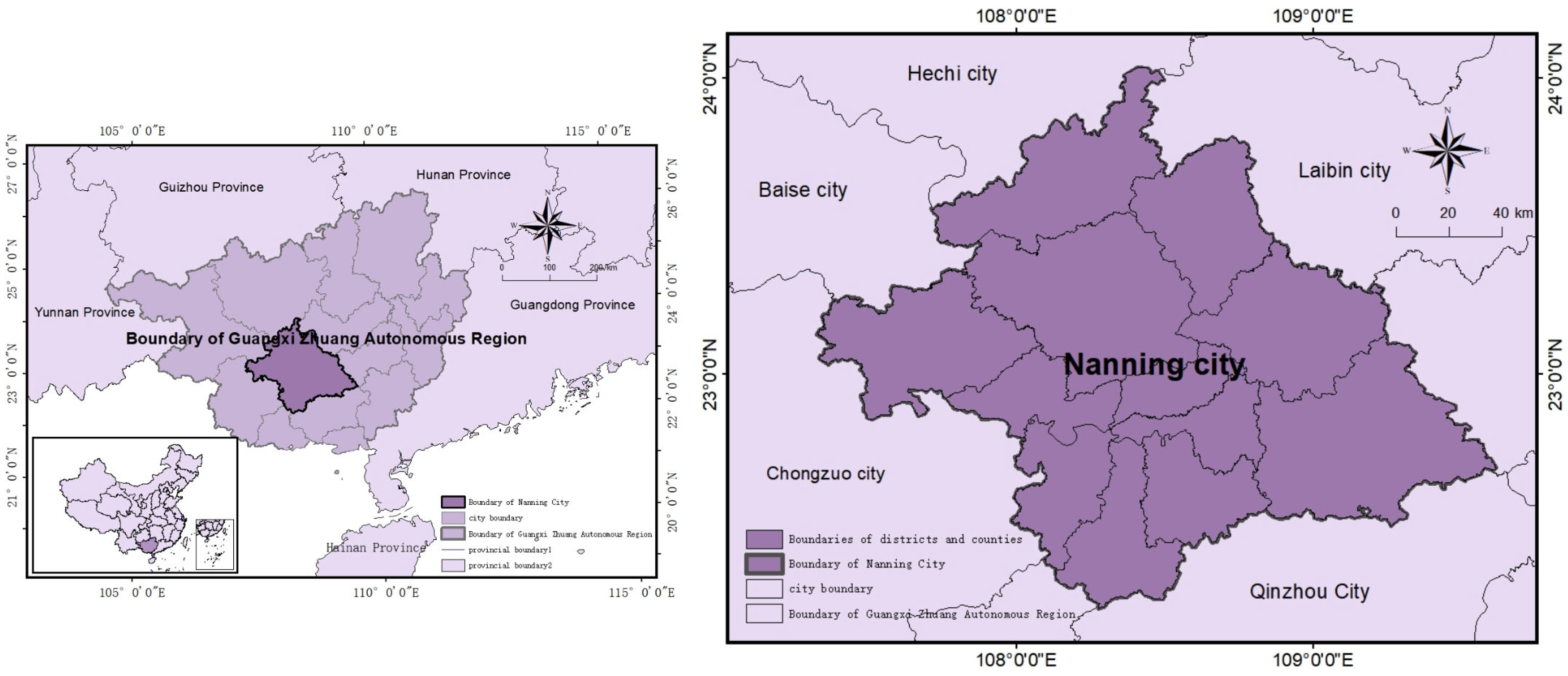
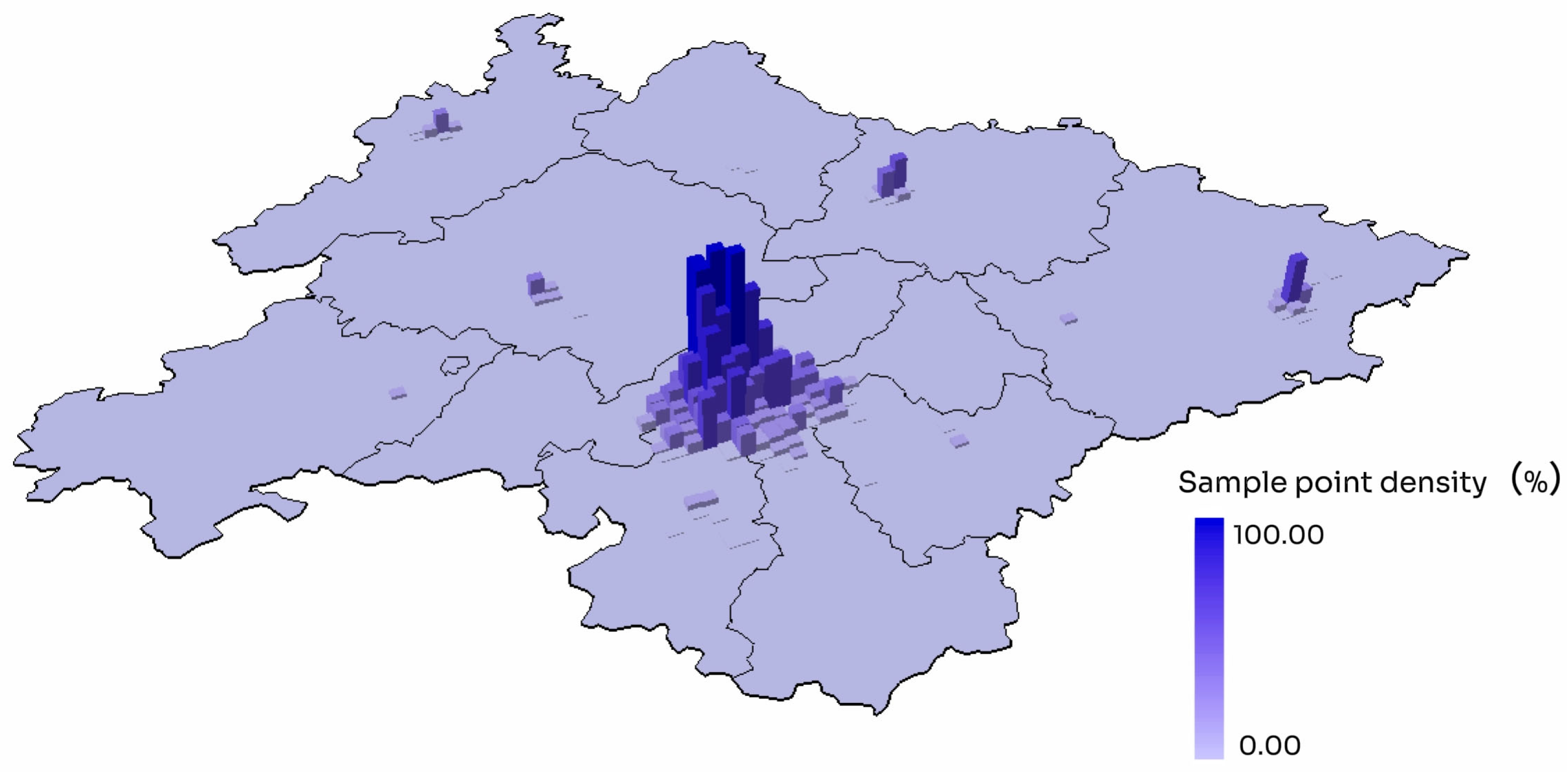
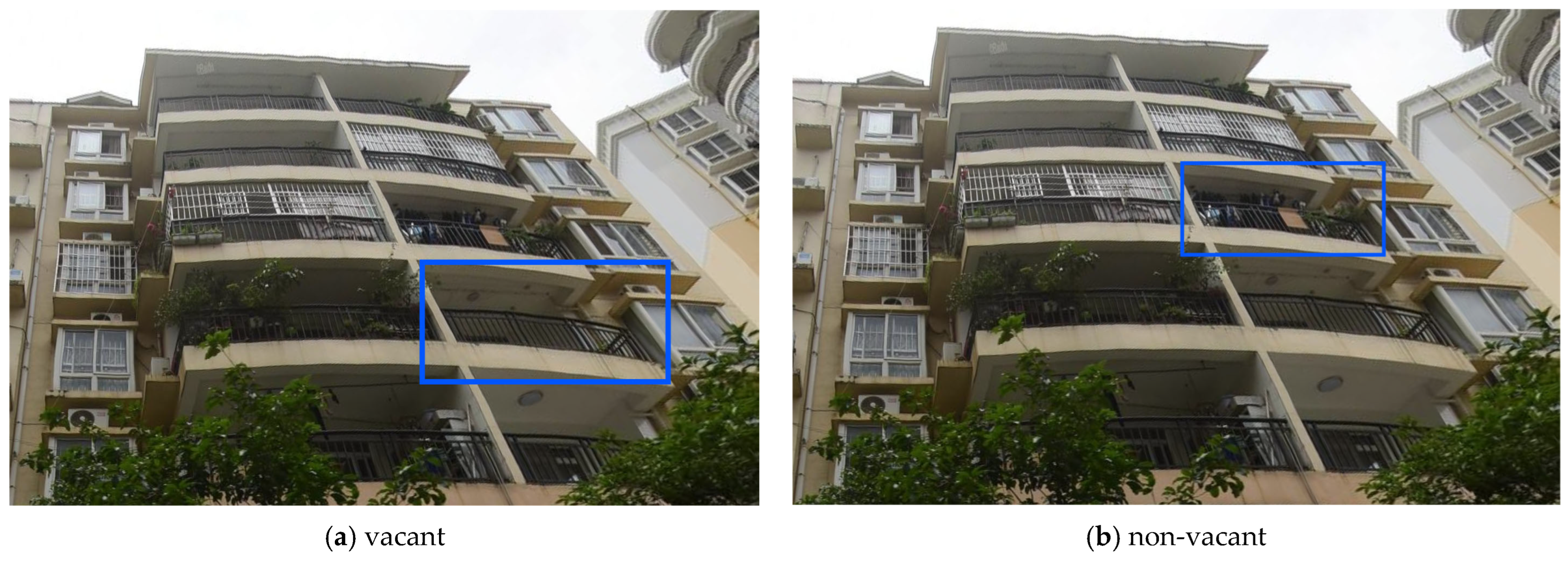
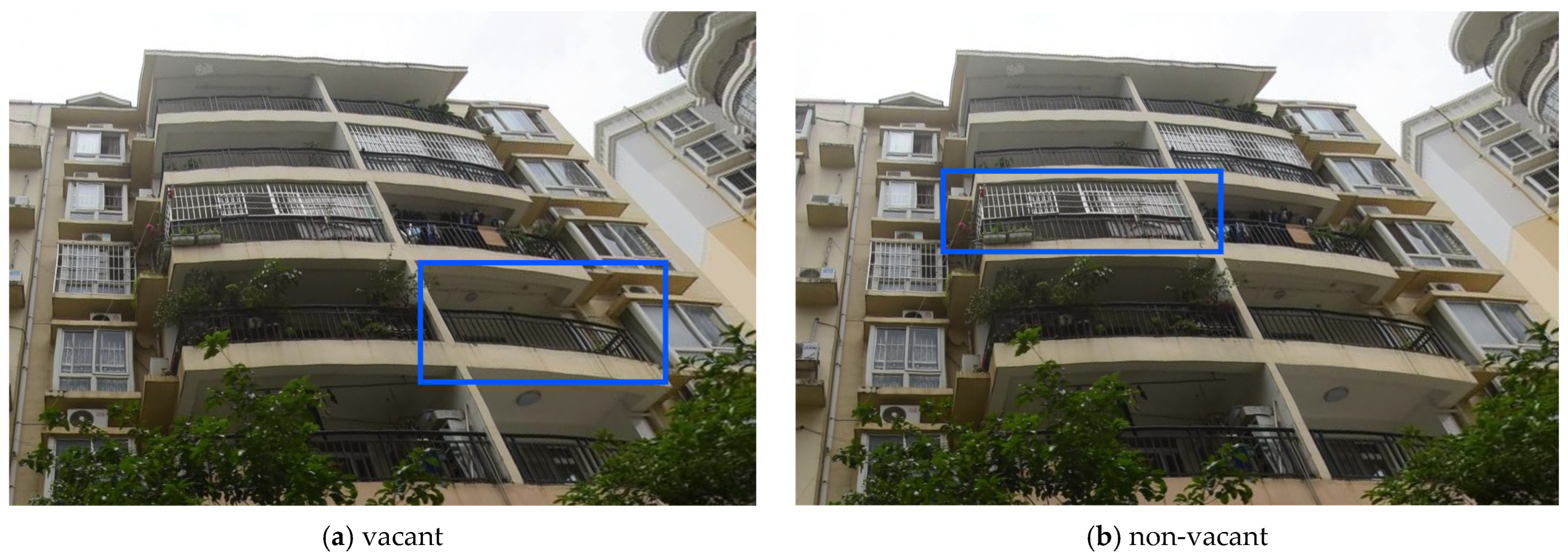
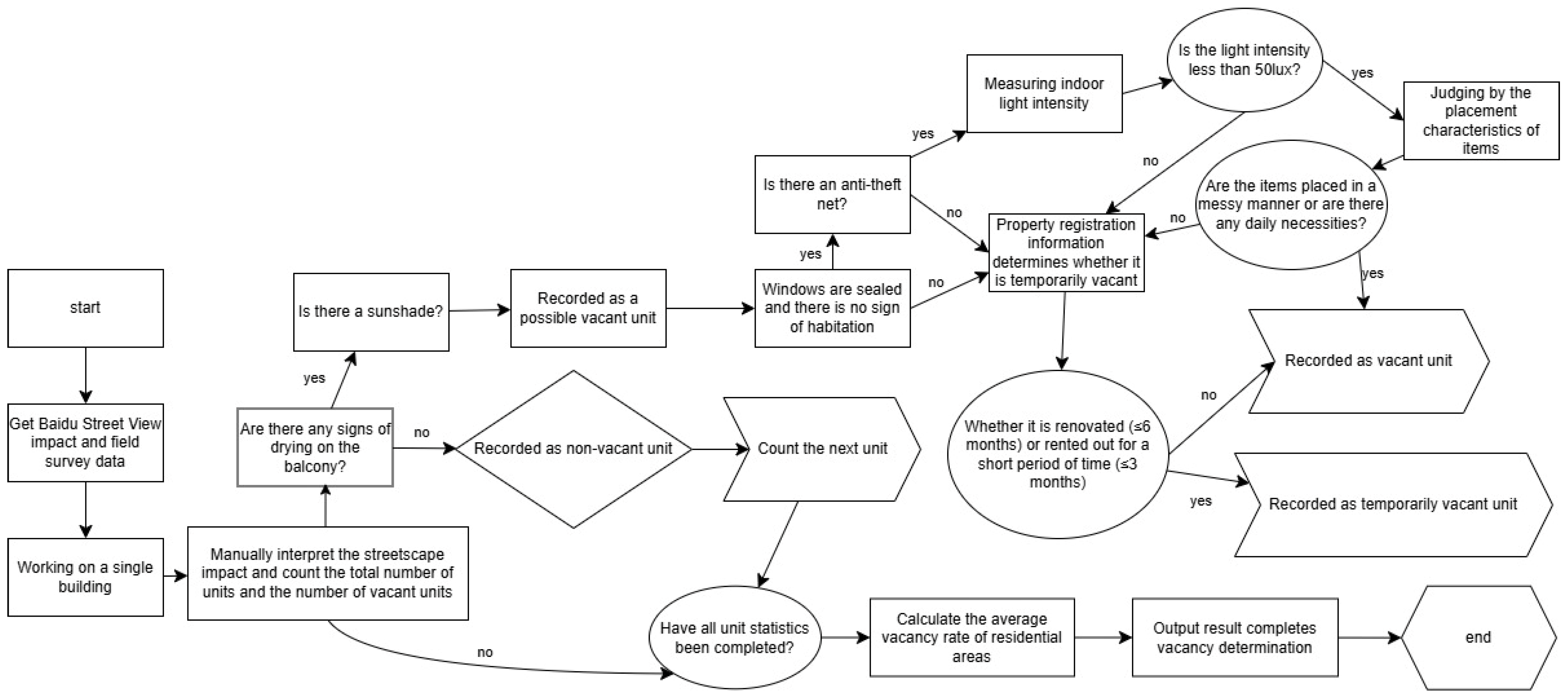
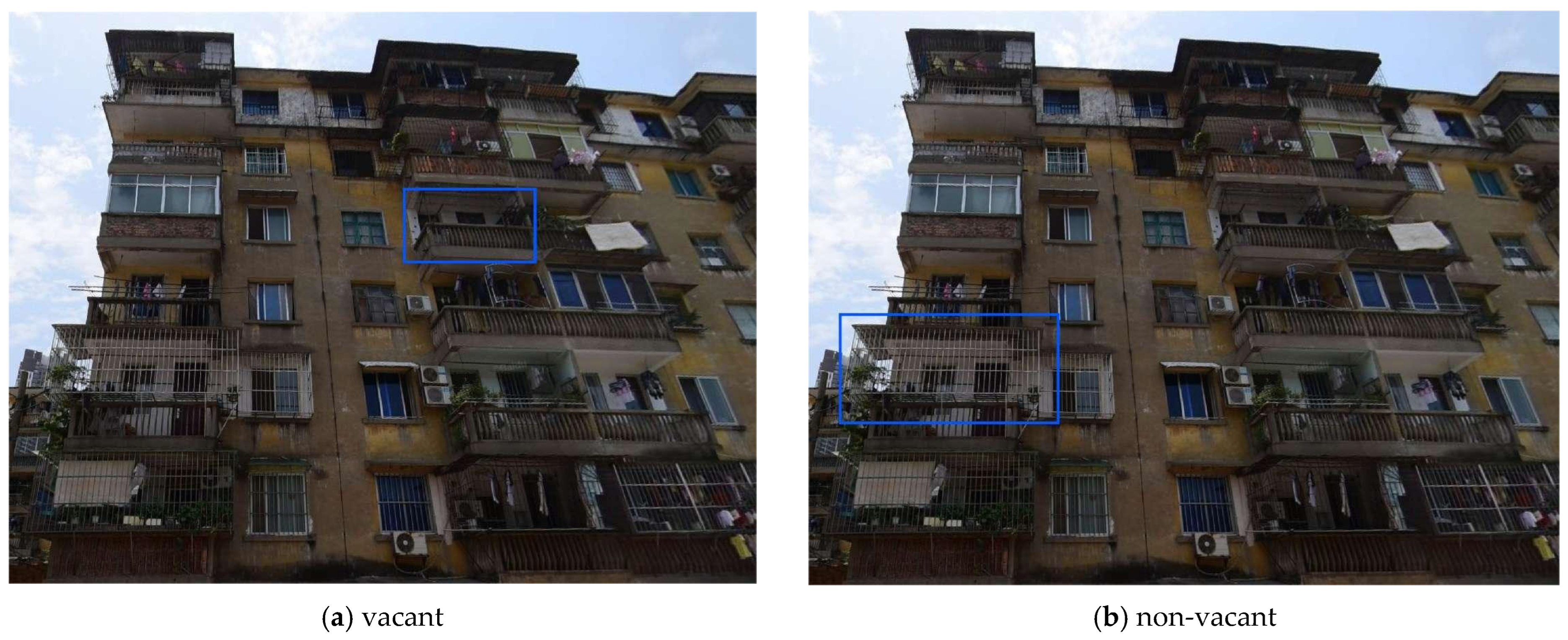
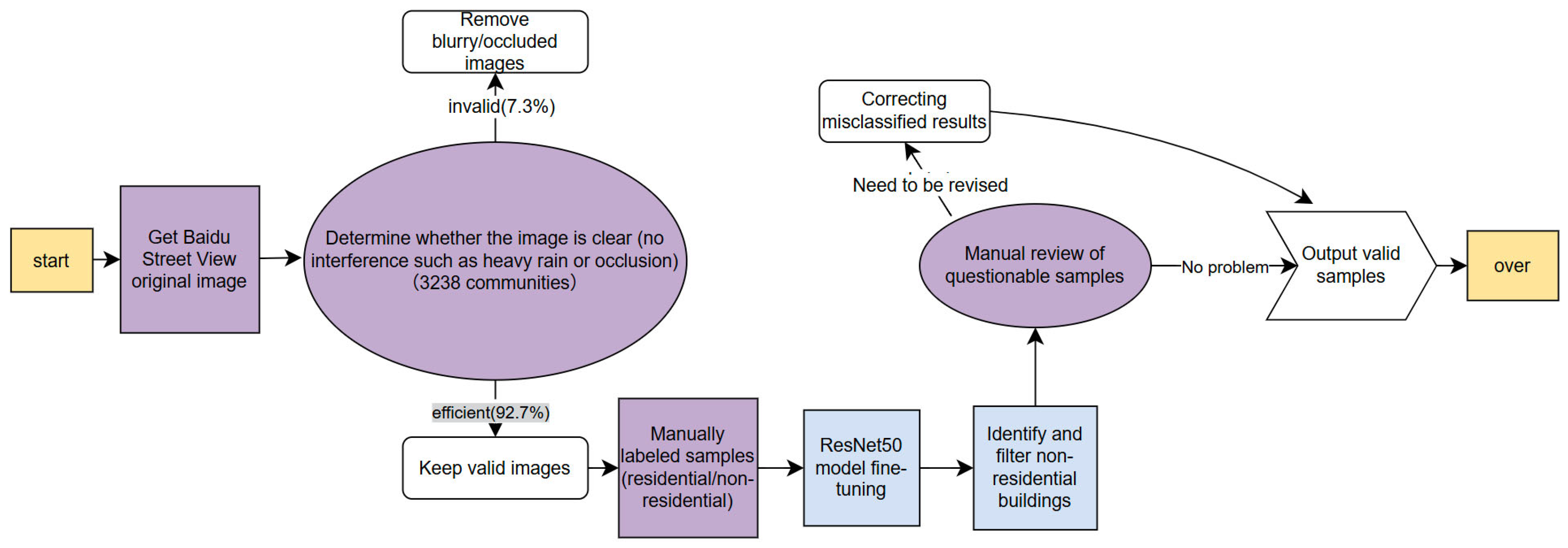
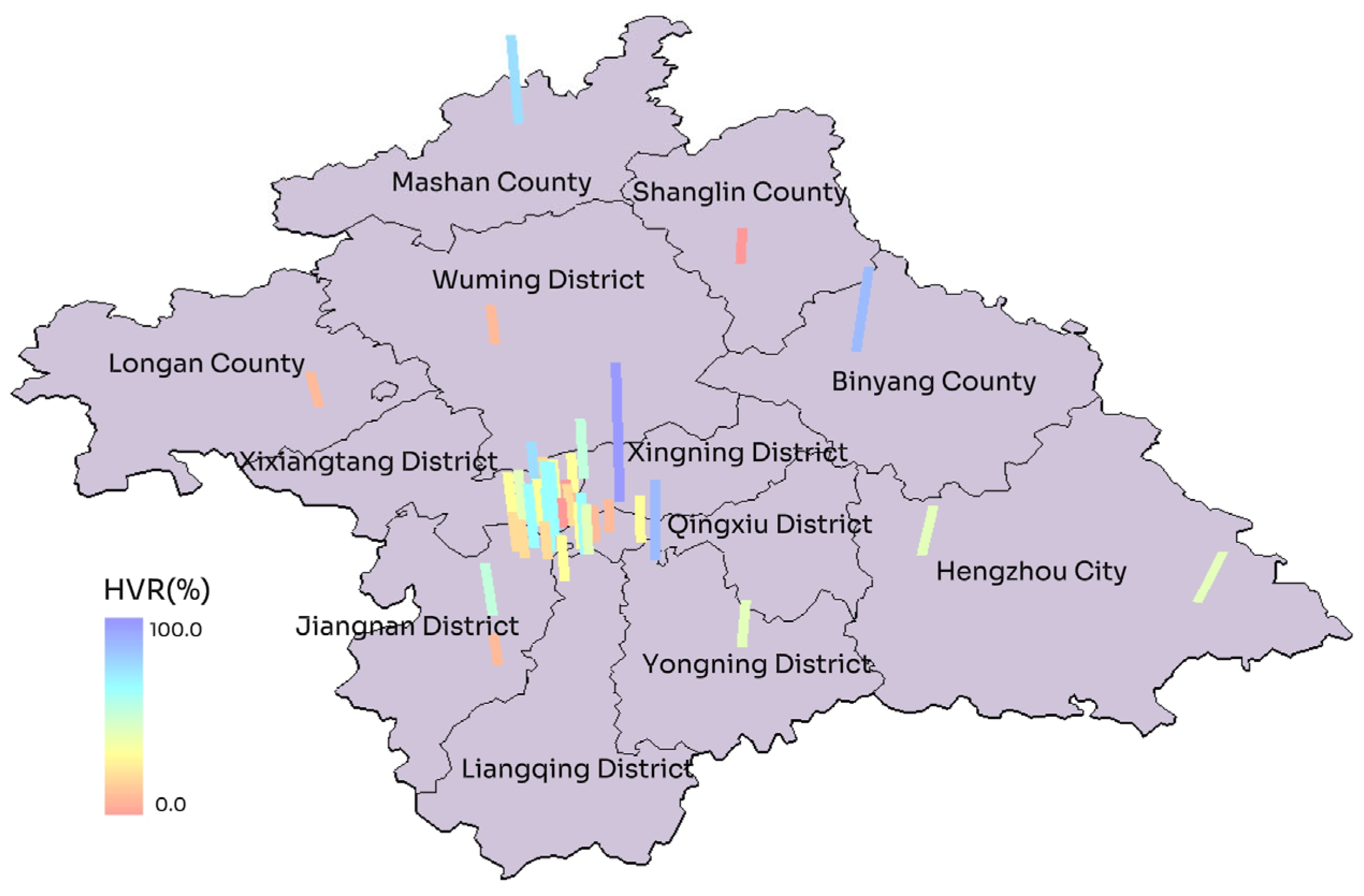
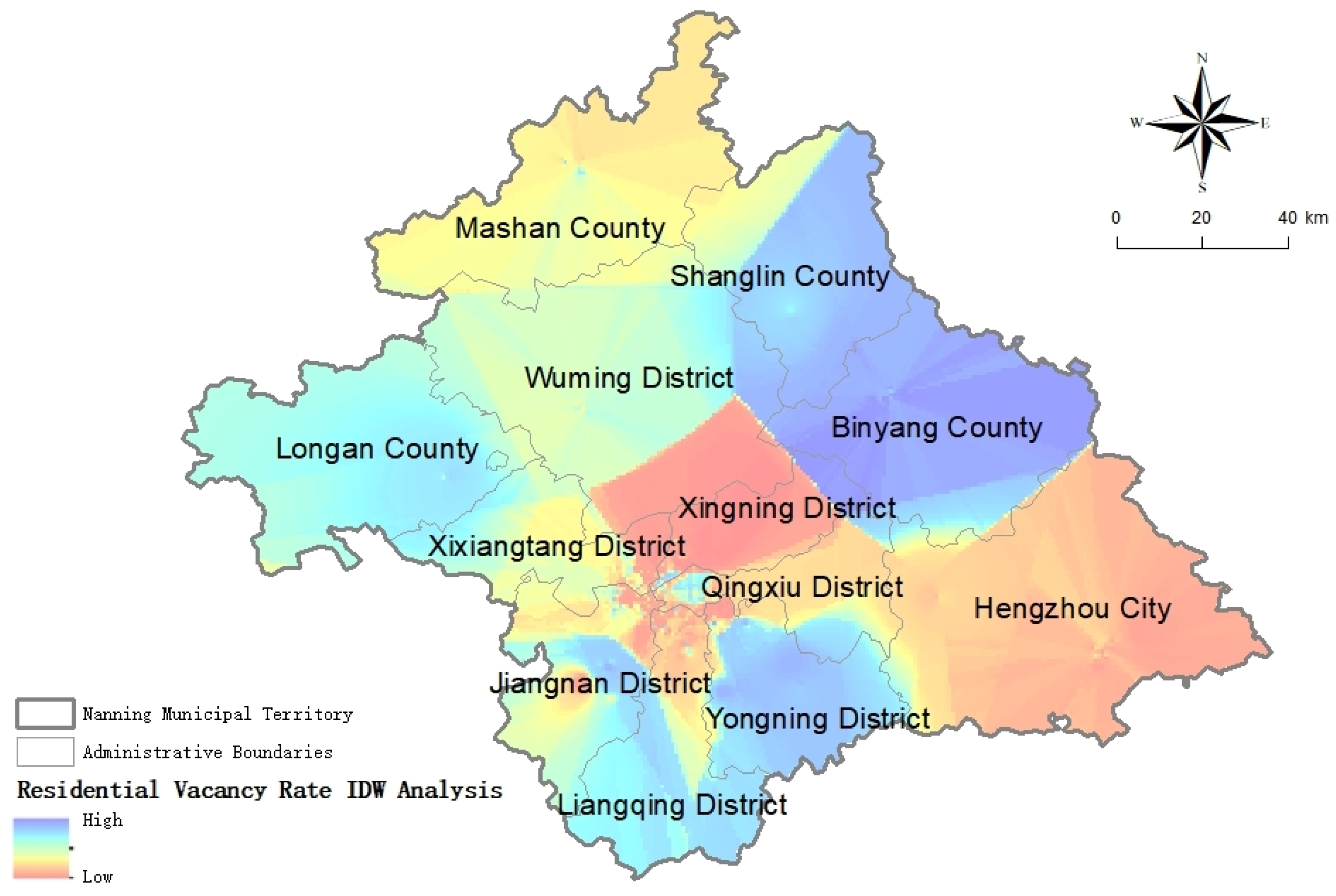
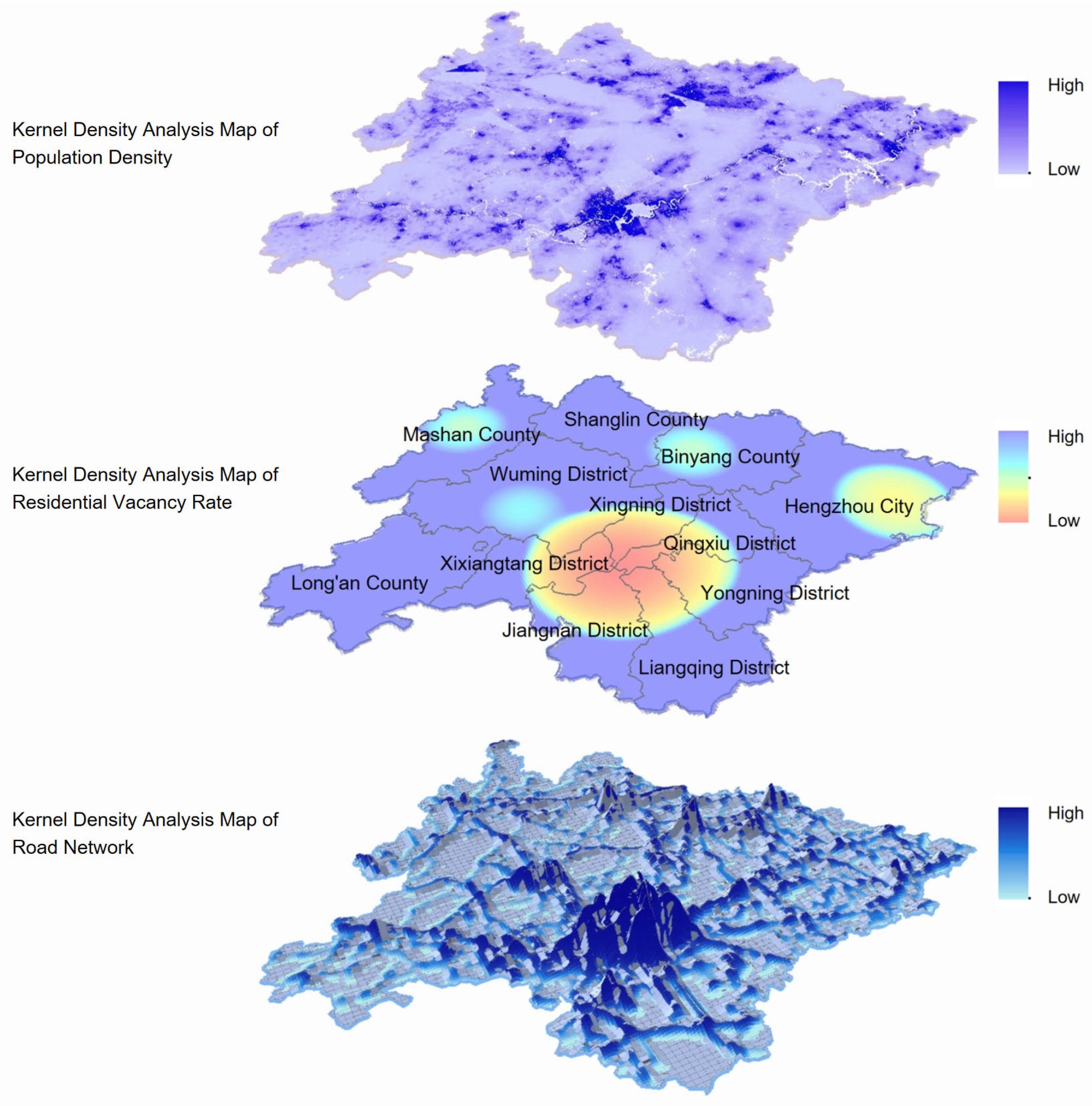
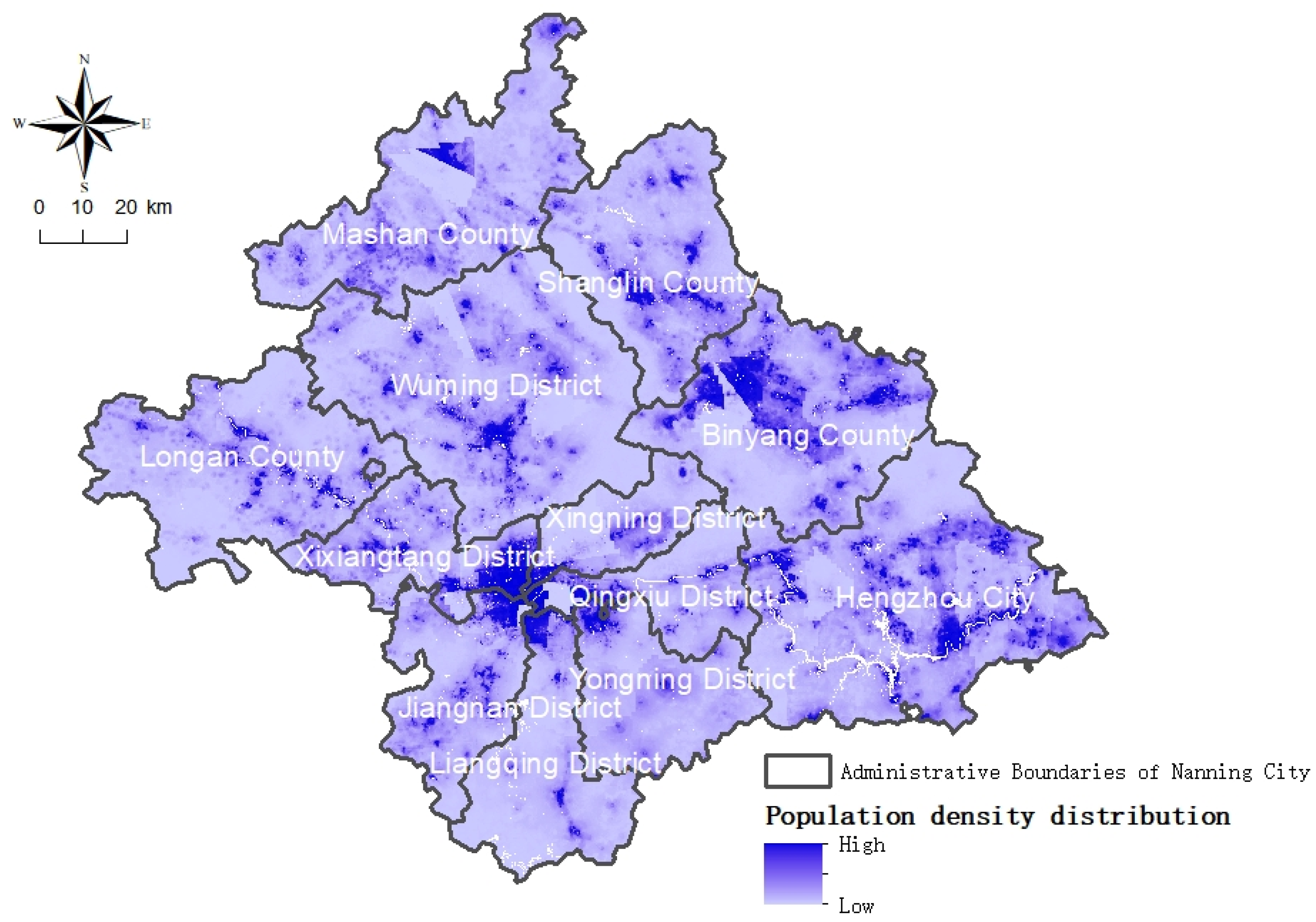
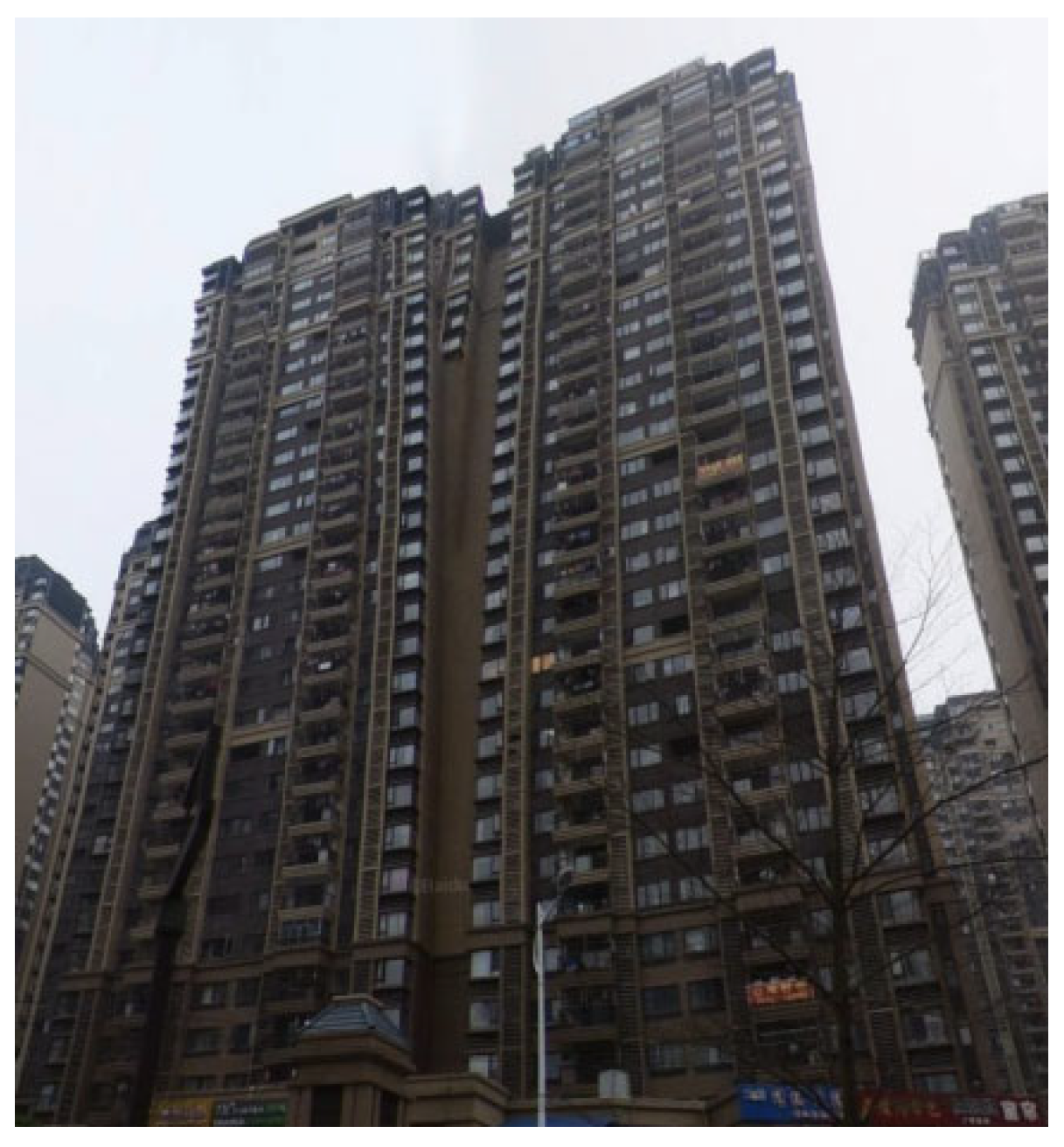
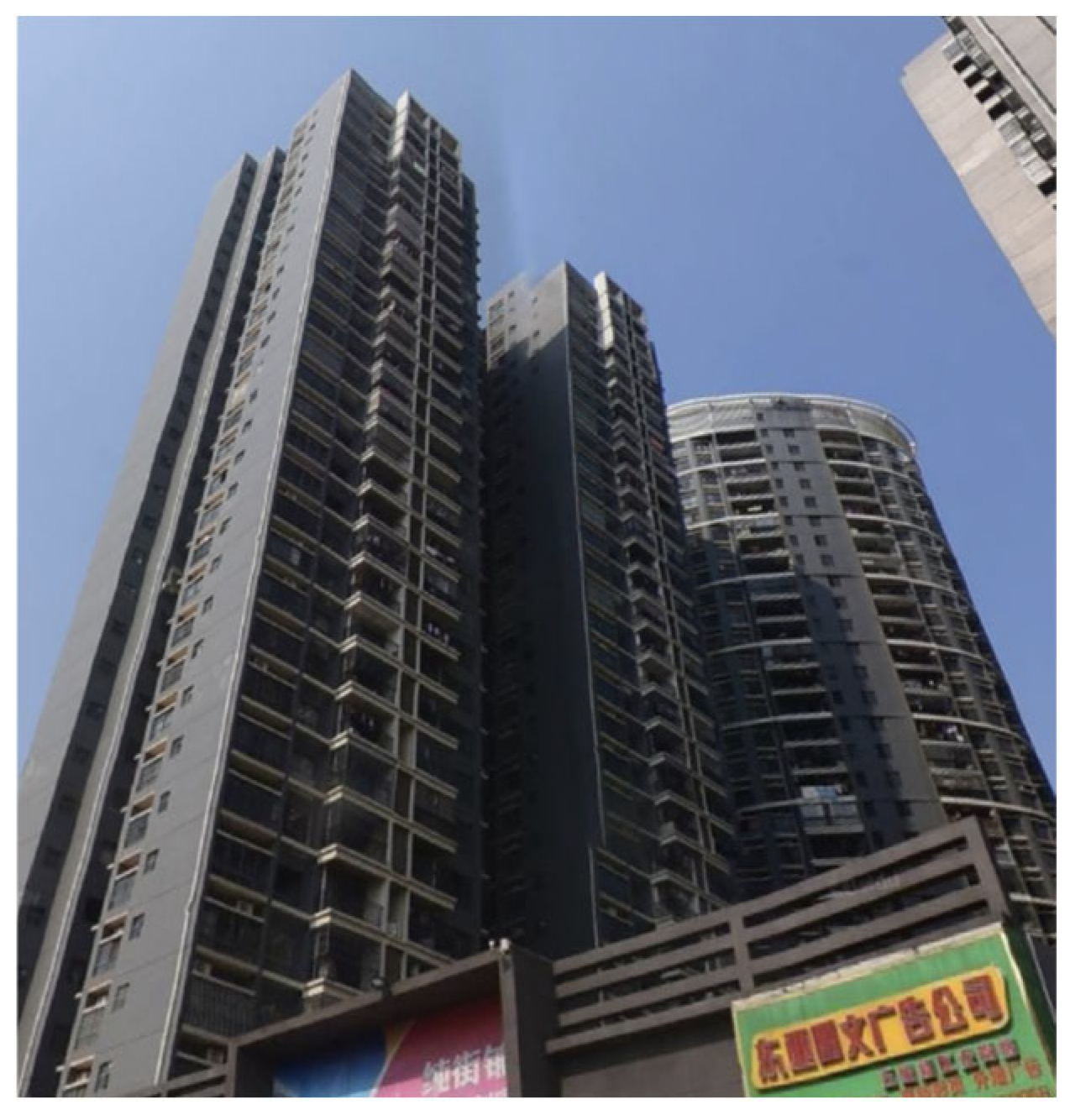
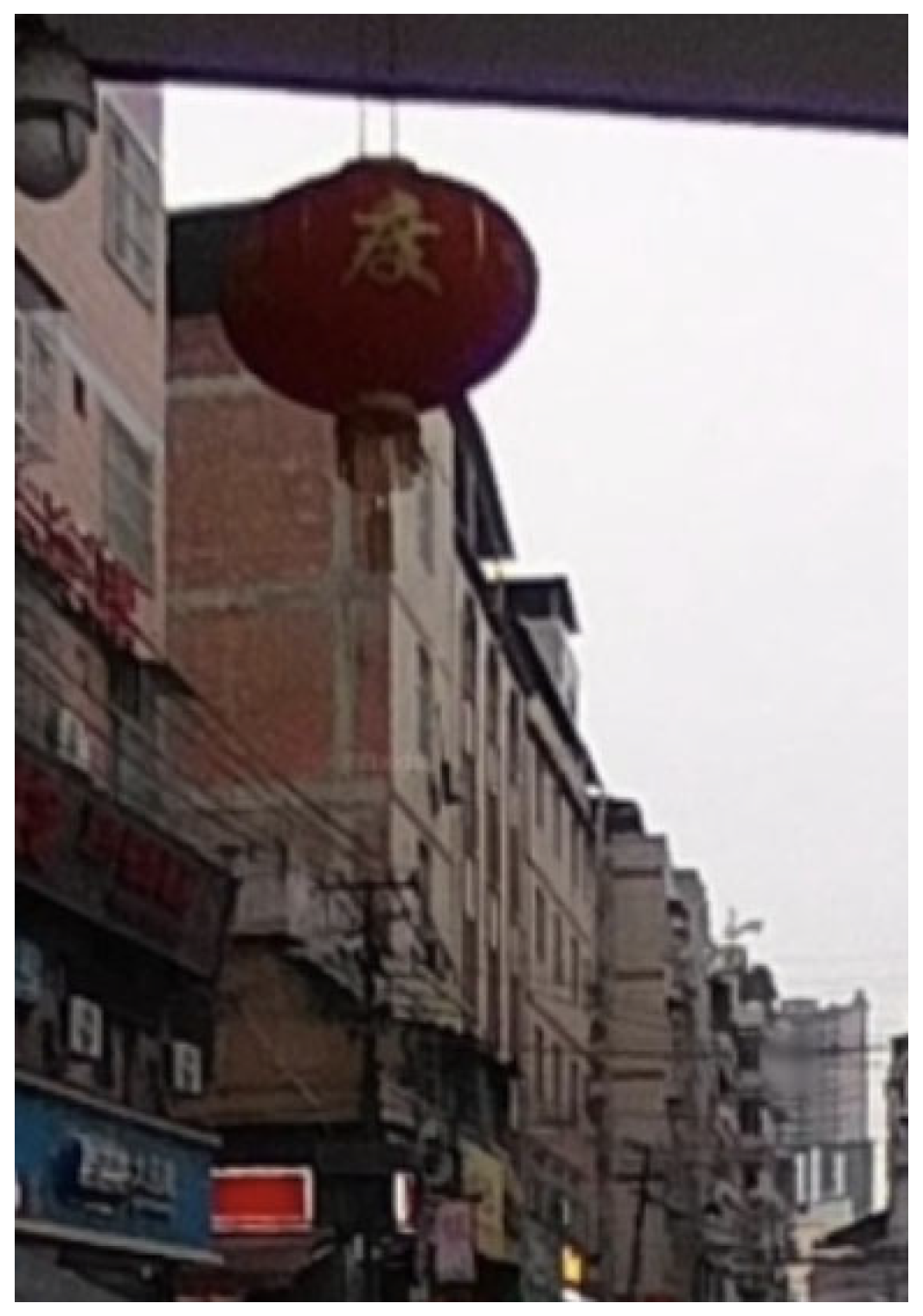
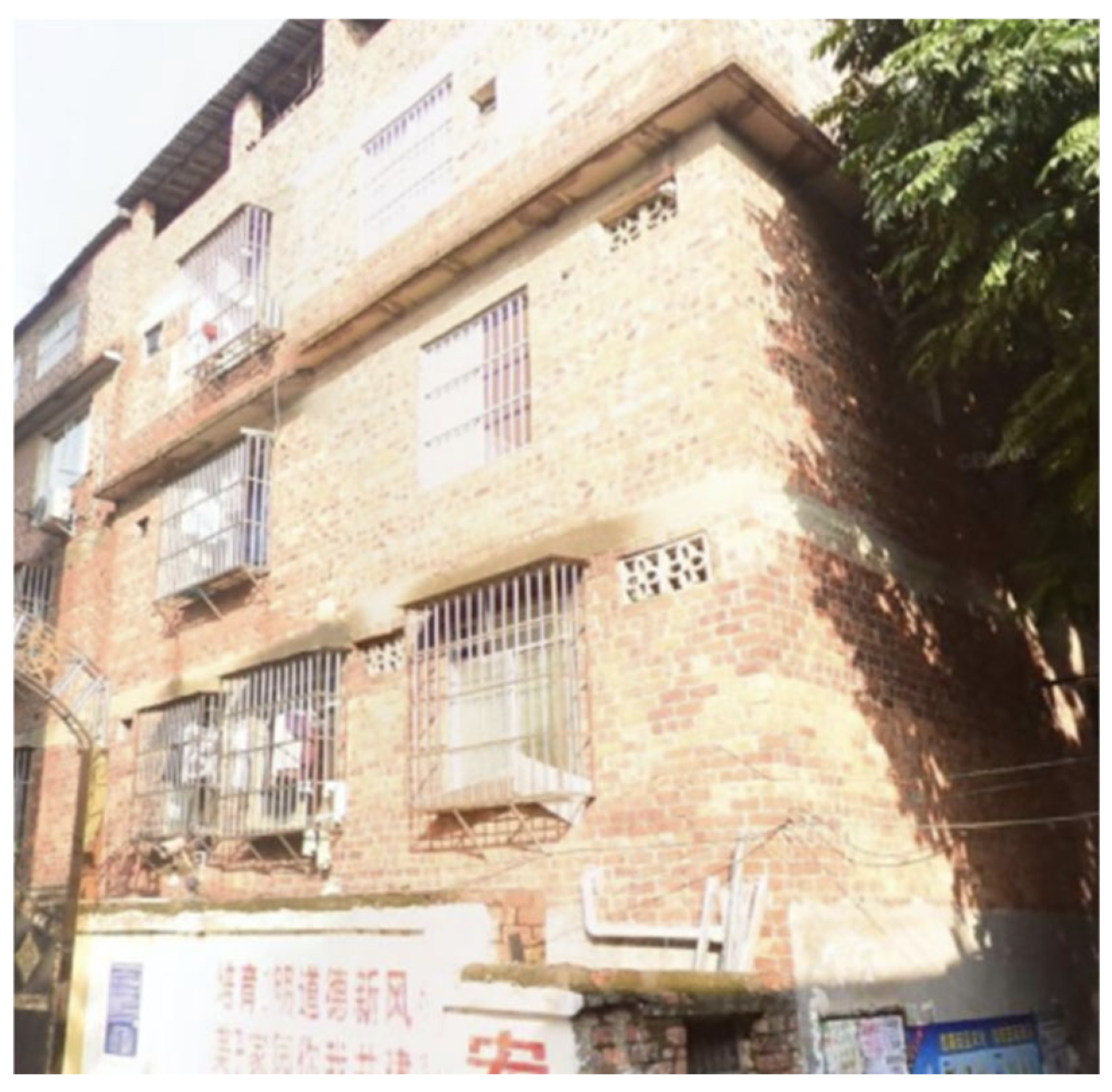
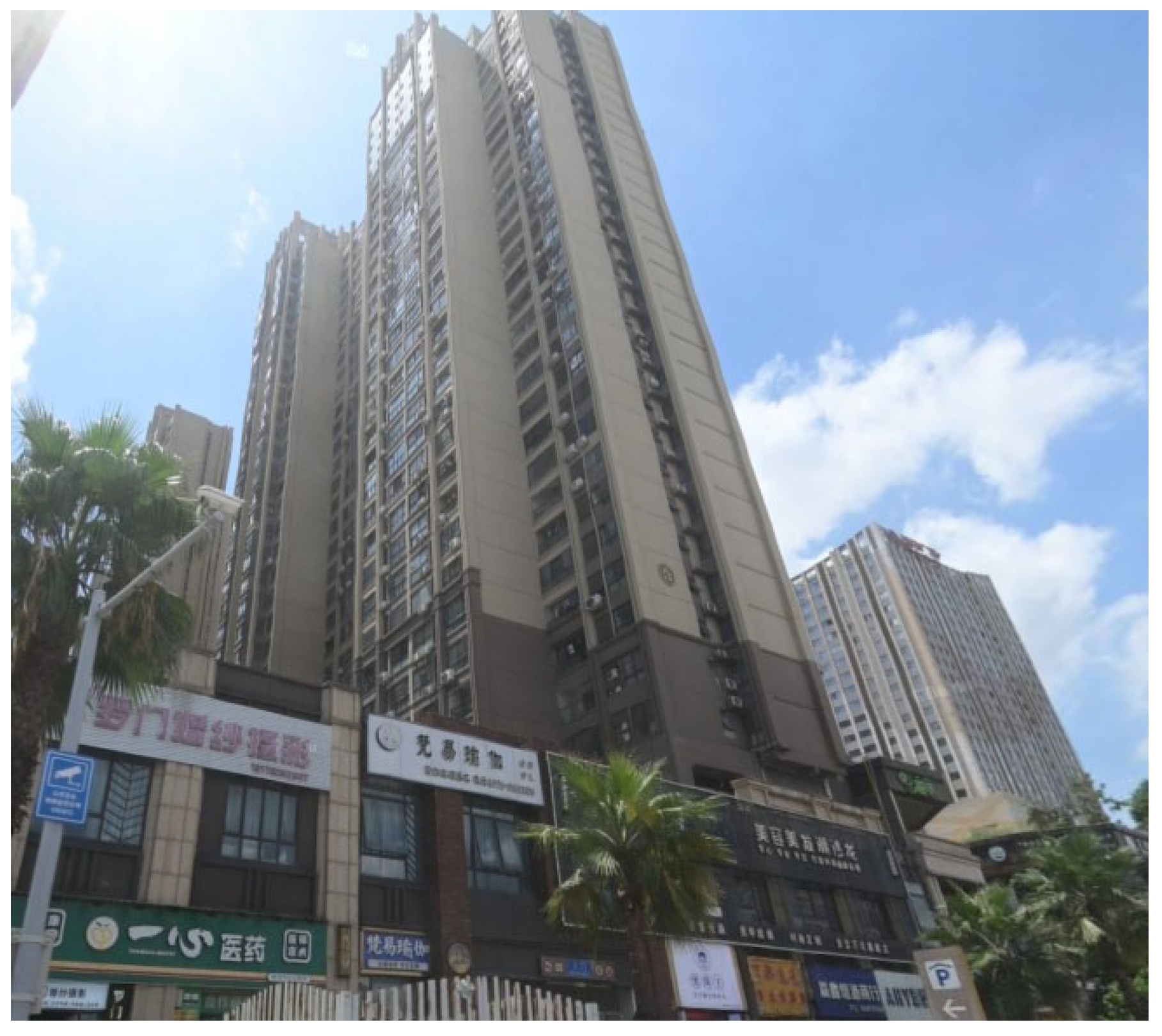
Disclaimer/Publisher’s Note: The statements, opinions and data contained in all publications are solely those of the individual author(s) and contributor(s) and not of MDPI and/or the editor(s). MDPI and/or the editor(s) disclaim responsibility for any injury to people or property resulting from any ideas, methods, instructions or products referred to in the content. |
© 2025 by the authors. Licensee MDPI, Basel, Switzerland. This article is an open access article distributed under the terms and conditions of the Creative Commons Attribution (CC BY) license (https://creativecommons.org/licenses/by/4.0/).
Share and Cite
Zeng, W.; Liu, B.; Hu, Y.; Liu, W.; Fu, Y.; Zhang, Y.; Zhang, W. Estimation of Residential Vacancy Rate in Underdeveloped Areas of China Based on Baidu Street View Residential Exterior Images: A Case Study of Nanning, Guangxi. Algorithms 2025, 18, 500. https://doi.org/10.3390/a18080500
Zeng W, Liu B, Hu Y, Liu W, Fu Y, Zhang Y, Zhang W. Estimation of Residential Vacancy Rate in Underdeveloped Areas of China Based on Baidu Street View Residential Exterior Images: A Case Study of Nanning, Guangxi. Algorithms. 2025; 18(8):500. https://doi.org/10.3390/a18080500
Chicago/Turabian StyleZeng, Weijia, Binglin Liu, Yi Hu, Weijiang Liu, Yuhe Fu, Yiyue Zhang, and Weiran Zhang. 2025. "Estimation of Residential Vacancy Rate in Underdeveloped Areas of China Based on Baidu Street View Residential Exterior Images: A Case Study of Nanning, Guangxi" Algorithms 18, no. 8: 500. https://doi.org/10.3390/a18080500
APA StyleZeng, W., Liu, B., Hu, Y., Liu, W., Fu, Y., Zhang, Y., & Zhang, W. (2025). Estimation of Residential Vacancy Rate in Underdeveloped Areas of China Based on Baidu Street View Residential Exterior Images: A Case Study of Nanning, Guangxi. Algorithms, 18(8), 500. https://doi.org/10.3390/a18080500









